Would you ever expect young baby animals being taught things? If you didn’t, then you can learn about some skills learned by reading this summary!
The first animal that gets taught essential skills is none other than the hippo who needs to learn to bounce off the bottom of a river to take a breath needed. Baby hippos don’t have the instinct to know how to swim immediately, so they have to be instructed by mother hippos. If a baby hippo doesn’t know how to swim, it won’t survive and won’t be able to take a breath. Mother hippos demonstrate bouncing off the bottom of the river to the calves and starts to help them after they try it by themselves. After all, it does take trial and error to learn how to do something and master it.
The second animal is the nimble chimpanzee. They create tools that are used to meet their necessities, like a fishing probe for catching termites to munch on. Chimpanzees show these such tools to their babies. Young offspring can learn a lot by looking at the tool. They can then figure out which materials are best for making these tools and what a good tool looks like. This can be beneficiary for little chimpanzees so they can use these skills when they’re grown up. They will also teach their offspring how to recognize the right materials and tools. Like mother chimpanzee, like offspring.
The third organism is a tiny creature you would least expect to be taught something: a rock ant. Rock ants walk in pairs so they can find food together for the whole colony. Teachers tutor younger ants about how to find and where to find food. These survival skills are important so they can pass them on to future descendants and also for gathering food for themselves. The rock ants don’t really need a tiny map-they are the map!
The fourth critter that gets taught these skills is a cheetah. Younger cheetahs have to be taught how to hunt for prey. After all, how are they supposed to catch food as carnivorous predators? Mother cheetahs take young cheetahs along so they can see what the mother does. The mother demonstrates to its babies how to catch food. The babies soon try by having the mother cheetah bring food to them and having the offspring take it. At first, young cheetahs will attempt to snatch baby gazelles. When they’re ready, they’ll try to capture adult gazelles. The offspring will grow up into adults and teach their offspring the basics.
The bottlenose dolphin, the fifth organism taught these skills, has to grab sponges from the sea floor and make sure they don’t get harmed in the process. If the youngling attempts to do this, it might end up wounding itself from a sharp object, like coral. This is why the mother dolphins have to show calves how to obtain these sponges the orthodox way. Their potential and dexterity also has to do with their gender-almost all daughters become excellent “spongers”, the act of scouring the sand for sponges, but only half of the sons turn out to be magnificent “spongers”.
The sixth creature is a fairy wren. You’ve probably never heard of this critter. Don’t worry, neither have I. However, their skills are extremely impressive. Adult fairy wrens use secret codes and teach them to their babies while they are still in their eggs! This is because cuckoo birds sometimes put their chicks into fairy wren nests so that the wrens will be deceived into raising them. The parents tell apart their babies how? Well, if the offspring knows the password that was learned when they were in an egg, then the parents will figure out whether it’s a cuckoo bird or not. In fact, most of the cuckoo birds even attempt to guess the code, but they fail. That’s very clever, fairy wrens!
Lastly, but not least, is the golden lion tamarin. These primates teach their offspring where to find food in order to survive. The older ones use a specific call to signal to young ones to find the food. They might show where the food is, or they might not. Either way, the offspring still know where and how to find it. It’s not the most profound and intriguing competences. However, it’s still something the young tamarins can put to good use when they become adults.
In conclusion, all of these animals and their skills that are taught to the offspring are pretty extraordinary. My personal favorite was the fairy wren’s secret code. It’s cunning so that the adults can identify the imposters in the nest. I also love the fairy wren’s adorable appearance, and it really lives up to its name. However, like I said earlier, these animals all have incredible proficiencies that can be put to outstanding use in their futures.
Written by Kruti Patel



